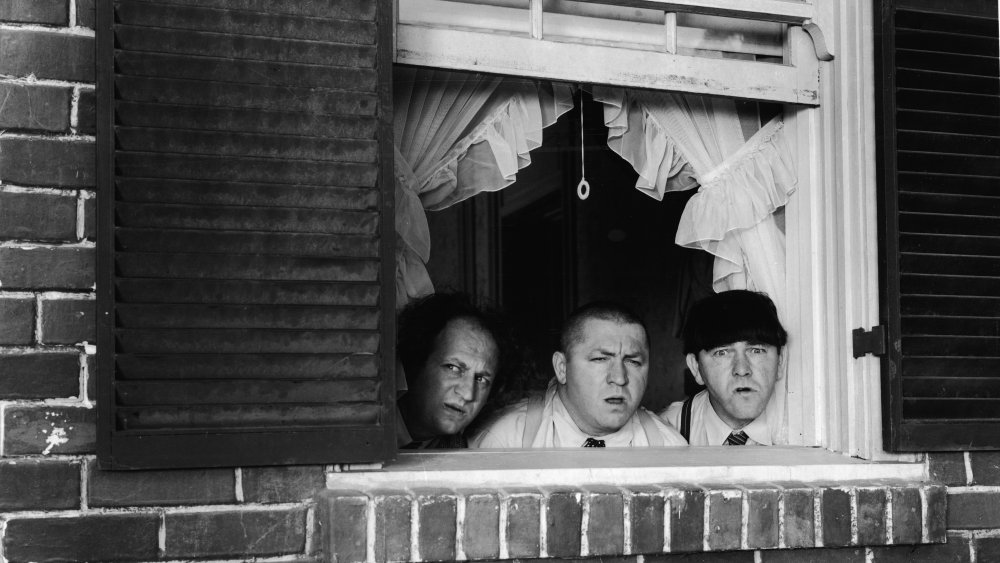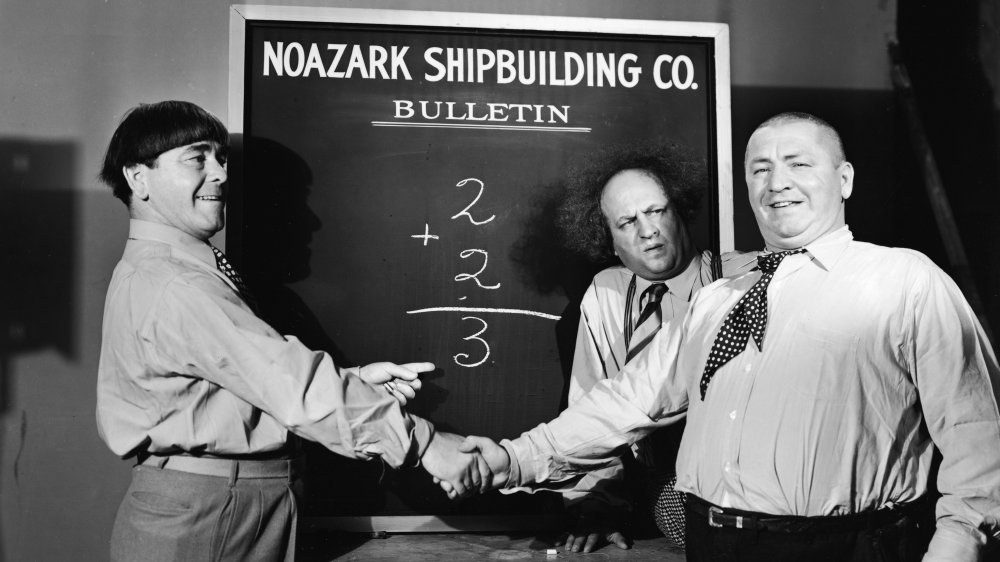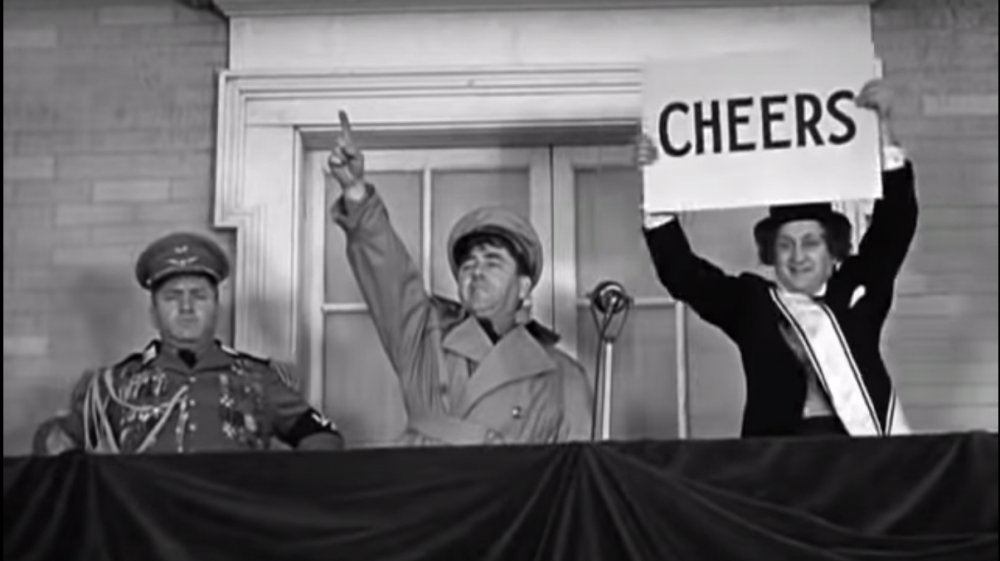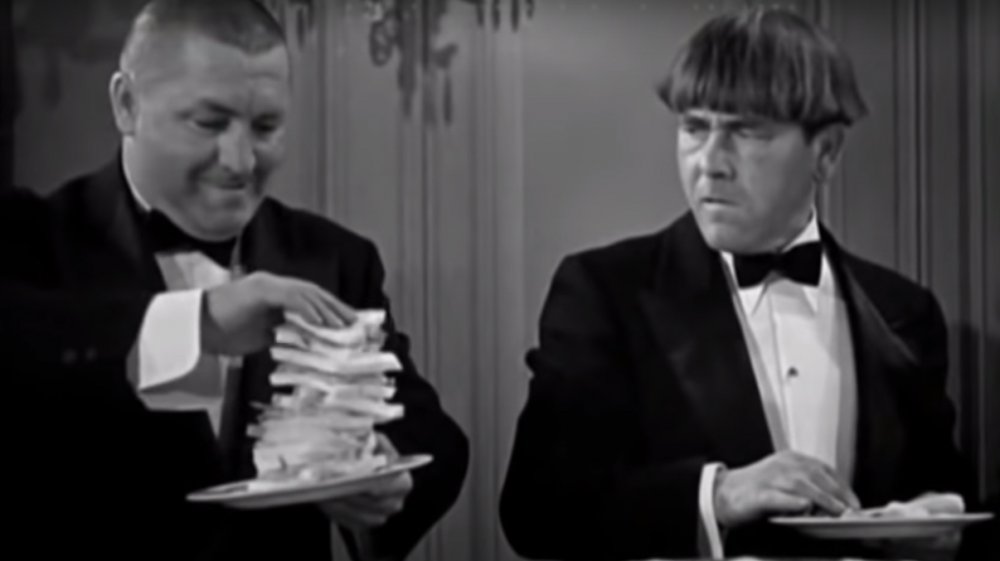The Real Reason The Three Stooges Were Fired
There was a time when a night at the movies was an entire evening's entertainment: a cartoon, a short subject (usually a comedy — for instance, The Three Stooges), a newsreel, a B movie — made on the cheap, with a lower budget and starring lesser-known (and therefore cheaper) actors — and then the A movie, the main feature. Hollywood was most assuredly an industry, and product was cranked out like a factory: According to Den of Geek, at the top of its game, MGM alone released 50 feature films per year. That's one movie about every nine days. (Let's repeat that: A new feature film every nine days.) And that was just the features. Don't forget all of the other, lesser productions. History estimates that around 7,500 feature films were released between 1930-45.
Tickets sold even during the Great Depression. Individual theaters sometimes engaged in special promotions to lure people in, but on the whole, it was relatively inexpensive entertainment. The University of Houston's Digital History site relates that 60-80 million people went to the movies at least weekly. Movies provided escapism, whether in the form of morality tales about the evils of crime, reinforcing values with wholesome family stories, or singing and dancing provided by Fred Astaire.
The Stooges worked for decades for Columbia Pictures
The cinematic popularity of Shirley Temple, a dimpled pre-schooler with off-the-charts cute, led President Franklin Roosevelt to observe, "As long as our country has Shirley Temple, we will be all right," as told by The Vintage News. After World War II, all of that began to change. It was the advent of television, per Media Post and others, with beloved actors appearing in people's homes for just the cost of investing in a TV set. Mind you, television was not a small investment in those early days; TV sets, depending on size and model — and they were only in black-and-white, not color — were priced from $129 to 10 times that amount, each. Reference reveals that there were but 10 companies making them at first, and five of those companies only made one model. The popcorn was cheaper, too. With significant fragmentation of the entertainment dollar that TV represented, movie ticket sales started to drop. The loss-leaders of the movie industry — the padding, so to speak — began to be eliminated in an effort to cut costs and remain profitable. Warner Bros. shut down their animation department. Newsreels were a thing of the past.
The Stooges were incredibly popular
The studios scrambled to stay afloat. Maybe people weren't actually going out to movie theaters like they used to, and Shirley Temple and Judy Garland had both grown up. But there was a back catalog dating back decades of films, good, bad, and indifferent. It wasn't unusual for a studio to re-release a movie that had done well in its original run — the Walt Disney factory famously waited about seven years before putting a successful movie back into circulation, since the original audience had grown up and a new potential group of viewers had taken their place. For their part, TV stations were hungry for content — they were rarely 24-hour operations, but still had trouble coming up with programming sufficient to fill the broadcast day. And then someone in a back office in Hollywood asked no one in particular: What if old movies were parceled out to local TV stations? It was a marriage made in heaven.
One of the downsides was that films which had been created with their own sense of cinematic pacing were unceremoniously hacked into ad-friendly sections for broadcast. Columbia Pictures, where The Three Stooges had labored since the early 1930s, was no exception. The operation never had a reputation for generosity with its players. (When the studio head, Harry Cohn, died, the funeral was packed, leading Red Skelton to observe, "It proves what Harry always said: Give the public what they want and they'll turn out for it.")
The transition to television gave the Stooges new star power
Columbia unceremoniously sold off their Stooge film catalog to Screen Gems, which in turn packaged the shorts into TV fodder. The Stooges saw none of that money. What was worse, the studio fired the Stooges without warning, without a dinner, without even a thank-you note. Moe Howard, in a remarkable show of generosity, stopped by the studio afterward to say goodbye to some of the executives. As Moe's daughter, Joan Maurer, tells the story that's related on Public Domain Movies, the guard refused him entry, because Moe — a man who had worked faithfully for the studio for decades — didn't have a current gate pass.
The Stooges were victims of the times and the economics — but also the benefactors. The Stooge films became instant hits (so to speak), especially with children, and their careers were instantly revitalized. There were live performances, cartoon series, comic books, new filmed skits for TV, bubblegum cards, and a series of successful feature films. It could be well and truly said that The Three Stooges got the last nyuck.



